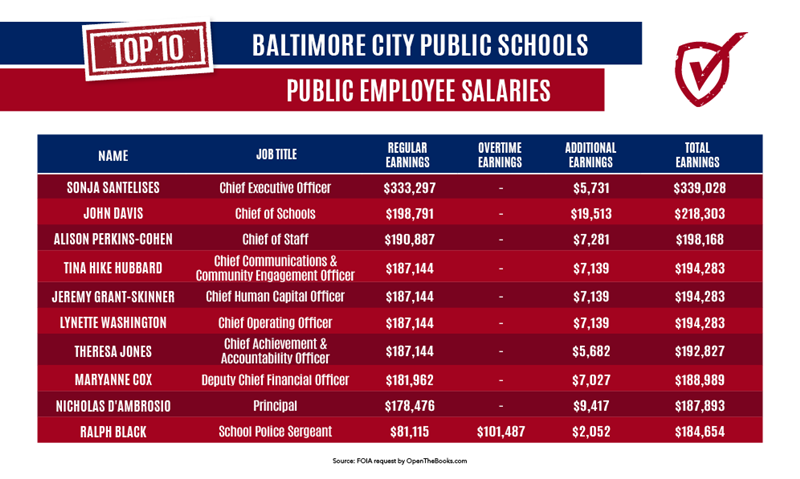



By Adam Andrzejewski
A Baltimore mom recently learned her high school senior had a 0.13 GPA yet ranked 62/120 in his class. The student had flunked all but three classes during his first three years of high school.
How could this student be ranked in the middle of his class? Project Baltimore and the local FOX 45 News published the findings. A school spokesperson wouldn’t comment on the specific case, but provided general background.
So, our auditors at OpenTheBooks.com investigated the district finances. Here’s what we found.
The district ran on a $1.4 billion budget for only 78,000 students – a cost of $18,000 per pupil. Maryland state taxpayers put in approximately $1 billion, and the balance came from local and federal taxpayers.
Then, federal coronavirus funding kicked in. During 2020, $85 million flowed into the district from the congressional CARES Act while the schools remained close for classroom learning.
For Baltimore City Public School employees, it paid to be virtual. Baltimore spent more than half a billion dollars last year on payroll, $648.5 million.
$5.5 million paid 20 highly compensated administrators
CEO Sonja Santelises ($339,028) and her chief of staff, Alison Perkins-Cohen ($198,168), collectively earned nearly $700,000 in pay, perks, pension funding, and health insurance benefits.
Santelises’ cash compensation was more than $126,000 higher than that of the U.S. Secretary of Education, a cabinet-level position.
Chief of Schools John Davis made $218,303 in base salary alone. Tina Hike Hubbard, the “Chief Communications & Community Engagement Officer” earned $194,283.
Other highly compensated employees included Jeremy Grant-Skinner, the “Chief Human Capital Officer” ($194,283); Lynette Washington, the Chief Operating Officer ($194,283); Theresa Jones, the “Chief Achievement & Accountability Officer” ($192,827); and Maryanne Cox, the Deputy Chief Financial Officer ($192,827).
Furthermore, we found that the district employed more non-teachers than teachers. Nearly 10,000 employees worked all 12 months last year; however, only 4,500 were teachers. Therefore, there were 1.1 employees for every teacher.
Full-time teachers paid $335 million
Those 4,500 teachers were paid $335 million collectively ($74,500 on average) and cost taxpayers more than $100,000 each when adding perks and pension benefits.
In contrast, the Baltimore Catholic schools pay teachers an average of $40,000 per year. The Catholic schools went back to school last September for in-person instruction.
$700,000 paid to “hall monitors”—with no kids in the halls for nine months
Baltimore paid 24 “hall monitors” for the entire year at a cost to taxpayers of $698,639, or $29,109 per person. If the students weren’t at school, why were hall monitors necessary?
$8 million paid to the school police
Almost 100 officers (96) earned $6.1 million in base salary during 2020, a period when the schools were closed. Additionally, the district paid $2.1 million in overtime. Police sergeant Ralph Black made $184,654 in cash compensation last year and ranked as the tenth highest-paid employee in the district. His pay was increased by overtime amounting to $101,487.
Ten other school police officers made between $50,000 and $71,349 in overtime income. Among the entire force, the average officer picked up $25,000 in overtime work.
We reached out to the district for comment and a spokesperson responded:
“Many school police officers in City Schools perform other duties outside of the scope of their City Schools responsibilities during off-duty time. In this case, the majority of the overtime is non-school system related overtime, which is reimbursable by outside agencies. In the past year, examples of off-duty work for outside agencies included work at COVID-related meal sites at recreation centers, election sites, COVID-19 test sites, and more.”
$1 million spent on achievement and accountability office
Six people make up the BCPS Achievement and Accountability Office. They cannot be held accountable for everything that goes wrong (or right) in the school system, but they do make a lot of money working there.
All six employees made over $100,000 a year in 2020, with the lowest paid, Mark Kennedy, still making $111,118 as a “special assistant.” Theresa Jones, BCPS’ “Chief Achievement & Accountability Officer,” made $192,827.
Office of Equity – healing racial trauma
Baltimore City Public School’s Office of Equity (a three-person, $235,566 office) paid Its executive director Tracey Durant $143,800 in 2020. It offers a “2-day Introduction to Racial Equity Seminar” for staff and makes available resources, some of which discuss fighting “white silence.”
Resources on its website note, “White people have a role in undoing racism because white people created and, for the most part, currently maintain (whether they want to or not) the racist system that benefits white people to the detriment of people of color.” (Source: the third item on page 4 of BCPS Equity Office resources under “Educating Yourself” “12 Ways to Be A White Ally to Black People.”)
FURTHER READING
After the story broke about the senior with the less-than-one-percent GPA, Baltimore Mayor Brandon Scott “implied during a press conference that education lapses in city schools were tied to a lack of funding. ‘We have a school district that’s been underfunded by $300 million a year by our state,’ he said.”
The Mayor faced a “swift rebuke from Maryland’s Public Policy Institute Director Christopher Summers, who said the city doesn't have an underfunding problem but instead an overspending problem. ‘Baltimore City alone is spending 25.2% above the national average,’ he said.”
Baltimore’s Fox45’s Townhall on Baltimore Schools: